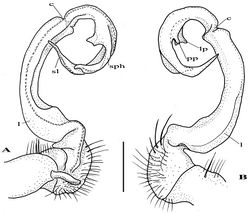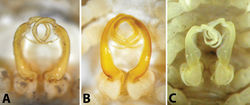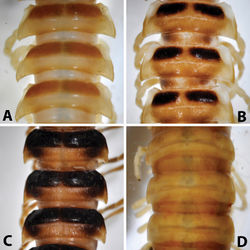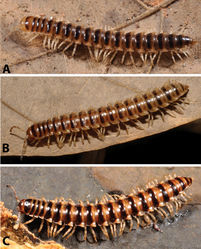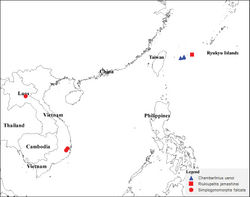Chamberlinius uenoi
| Notice: | This page is derived from the original publication listed below, whose author(s) should always be credited. Further contributors may edit and improve the content of this page and, consequently, need to be credited as well (see page history). Any assessment of factual correctness requires a careful review of the original article as well as of subsequent contributions.
If you are uncertain whether your planned contribution is correct or not, we suggest that you use the associated discussion page instead of editing the page directly. This page should be cited as follows (rationale):
Citation formats to copy and paste
BibTeX: @article{Nguyen2011ZooKeys156, RIS/ Endnote: TY - JOUR Wikipedia/ Citizendium: <ref name="Nguyen2011ZooKeys156">{{Citation See also the citation download page at the journal. |
Ordo: Polydesmida
Familia: Paradoxosomatidae
Genus: Chamberlinius
Name
Chamberlinius uenoi (Murakami, 1975) comb. n. – Wikispecies link – Pensoft Profile
- Riukiupeltis uenoi Murakami, 1975: Bulletin of the National Science Museum, Tokyo, {A}1(2): 105–107, fig. 9
- Riukiupeltis uenoi:– Nakamura and Korsós 2010[1]: Acta Arachnologica 59(2): 82
Material studied
Holotype male, NSMT-My 358, “Japan, Okinawa Pref., Is. Ishigaki-jima, Ibaruma, Sabichi-go Cave, 31 July 1973, coll. by S. Uéno” (NMNS).
New records: 2 males, 1 female, Japan, Ryukyu Archipelago, Yaeyama Island Group, Ishigaki-jima Island, Banna-dake, secondary forest, N24.3859°, E124.1651°, 30 August 2009, leg. Z. Korsós & Y. Nakamura (RUMF); 1 male, 2 females, Japan, Southern Ryukyus, Yaeyama Group, Iriomote-jima Island, Funaura, around university research station, N24.3929°, E123.7913°, secondary forest, 18 January 2011, leg. Z. Korsós (RUMF); 1 male, 1 female, Japan, Southern Ryukyus, Yaeyama Group, Iriomote-jima Island, Mihara, along Aira river, primary forest, N24.3400°, E123.9137°, in decaying log, 12 m a.s.l., 19 January 2011, leg. Z. Korsós (HNHM).
Distribution
. Japan, Ryukyu Archipelago, Yaeyama Group, Ishigaki-jima and Iriomote-jima islands.
Remarks
Murakami (1975)[2] when describing the species commented that the terminal portion of the gonopod is more complicated than that of Riukiupeltis jamashinai Verhoeff, 1939. He also agreed with Verhoeff, 1939 in its configuration, and placed his species in Riukiupeltis. However, the species uenoi, in fact, differs largely from the type species Riukiupeltis jamashinai in gonopod conformation.
After studying the type and freshly collected specimens, it became clear that the species uenoi is strongly different from Riukiupeltis jamashinai in its gonofemorite having a long lamina l, and a longer solenophore with basal processes pp and lp (Fig 3). We found that this species is more similar to Chamberlinius hualienensis Wang, 1956. Both Chamberlinius hualienensis and Chamberlinius uenoi comb. n. have well-developed paraterga (Figs 7A–B), large, slender and strongly concave gonofemorite, with a lamina at the mesal side (l in Fig. 3). Postfemoral region is demarcated from femorite by obvious cingulum (c in Fig. 3), and includes a long and large solenomere (sl) reaching femur, and a shorter solenophore (sph) with a basal lobe. However, the two species differ from each other in the length of the postfemoral processes, by the shape of the small basal processes on the solenophore, and by live colouration. The dark brown, transversal metatergal bands in Chamberlinius uenoi comb. n. are not divided by a median light brown longitudinal line (Figs 7C, 8C) as in Chamberlinius hualienensis (Figs 7B, 8B). Moreover, Chamberlinius uenoi comb. n. is strictly confined to undisturbed, natural evergreen broadleaf forests, and can only be found deep in decaying dead wood, whereas Chamberlinius hualienensis has a strong tendency for being synanthropic, and dispersed in large numbers onto many islands (especially in the southern part of Japan) by human activities.
Taxon Treatment
- Nguyen, A; Korsós, Z; 2011: A revision of the millipede genus Riukiupeltis Verhoeff, 1939 (Diplopoda, Polydesmida, Paradoxosomatidae), with comments on the status of related species ZooKeys, 156: 25-40. doi
Other References
- ↑ Nakamura Y, Korsós Z (2010) Distribution and diversity of millipedes of the Ryukyu Archipelago, with the Senkaku and Daito Island Groups: A literature review (Arthropoda: Diplpoda). Acta Arachnologica 59 (2): 73-86. doi: 10.2476/asjaa.59.73
- ↑ Murakami Y (1975) The cave myriapods of the Ryukyu Islands (I). Bulletin of the National Science Museum, Tokyo, {A} 1 (2): 87-113.
Images
|
